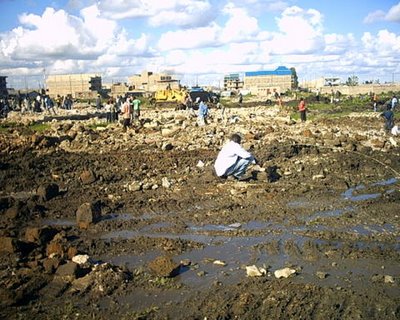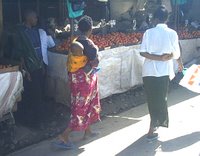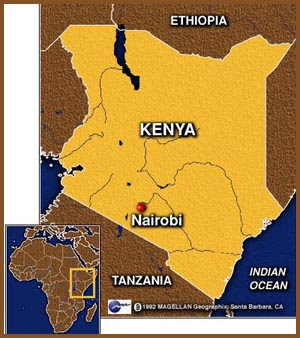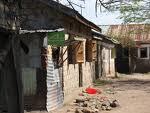:::::::::::::::::::::::::::::::::::::::::::::::::::::::::::::::::::::::::::::::::::::::::::::::::::::
Poetic Haibun
*****************************
Explanation
At the Ninth Kukai of the Haiku Clubs of Nairobi, on 30 October 2010 at the Children’s Traffic Park, two members of the “Bamboochas”, the Bahati Haiku Poetry Club, gave a presentation which tried out something new. This presentation consisted of free verse by Beryl Achieng’ lamenting the current building spree and the disregard for nature being subjugated for the sake of new housing, contrasted with haiku observations by James Bundi.
Kukai at the Children’s Traffic Park
Photo © David Kimani Mwangi
We wondered what to call this new form of poetry, and decided on the name “poetic haibun”.
:::::::::::::::::::::::::::::::::::::::::::::::::::::::::::::::::::::::::::::::::::::::::::::::::::::
Construction and Development
In the developing times,
trees and natural resources at stake!
Caterpillars and bulldozers at work,
motion day and night to construct
new apartments on the virgin land.
Where is our nature?
cracked tarmac --
the weight of the old
excavator
The dust and ash inhaled
all in the name of money making!
What is the cost of nature
compared to rental expenditure?
We need a change for a living!
yawning --
the dusty air enters
my throat
Dumping sites full of withered flowers,
roots and logs of the uprooted trees.
No beauty, no fresh air,
no shade from trees,
our natural resources at stake!
bare roots --
the withered flower
falls off
We are sorry Mother Nature,
we promise to maintain you
in the best way we can -- even
if it is by writing haiku
to register our complaints.
free verse : Beryl Achieng
haiku : James Bundi
:::::::::::::::::::::::::::::::::::::::::::::::::::::::::::::::::::::::::::::::::::::::::::::::::::::
We should like to hear your views on this. To me, the free verse reads very Kenyan, very passionate, very committed. The haiku, on the other hand, read like haiku, calm and observant without being judgmental. We may have discovered a very Kenyan form of presenting haiku to an audience!
This is something we shall need to work on, as Kenya Saijiki progresses. Culture, in Kenya, is now written and studied -- but in public fora, it is oral and very popular indeed. If haiku is to win its place in mainstream cultural events in Kenya, it will have to gain an oral form in which it can be presented to a large public audience, where it might be in competition with other performances such as dance, song, drama and long poems. Some form of haibun is most likely to provide the answer.
We shall be interested to read your views.
Congratulations, Beryl and James, for having taken us to new ground in haiku presentation!
Isabelle Prondzynski
.................................................................................
Short biographies
Beryl Achieng’
My name is Beryl Achieng', aged 18 years, born on 29 May 1992. I am the chairperson of the Bamboochas Haiku Club from Bahati Secondary School in Kayole, Nairobi (Kenya). I joined the haiku club in the year 2007, after which our Sensei Mr. Patrick Wafula introduced us to haiku, and he has ever since been guiding us in our writing.
My inspiration for writing haiku comes from nature.
The poem "Construction and Development" was about the current situation in Kenya. It was the result of the current developments that have led to construction of many roads and apartment blocks in our area.
Beryl Achieng’
Photo © Caleb Mutua
. . . . .
James Bundi
My name is James Bundi, the co-ordinator of the Bamboochas Haiku Club of Bahati Secondary School in Kayole. I joined the haiku club in the year 2008. This is due to the fact that it opened a vast field to expose what I think I have in me; being creative and observant.
The latest issue was about Construction and Development. I got a push to write about this issue due to the harm made to flowers and trees in our neighbourhood to pave way for construction of apartments. I shared the idea with Beryl Achieng' who took the task of creating a poem while I wrote the haiku that appeared in between the poem's stanzas.
We did the editing together and this gave rise to the presentation, which became a haibun.
James Bundi
Photo © Caleb Mutua
*****************************
Reactions
May I join Isabelle in her praise of this work of art !
And haiku in combination with other art forms is indeed a great way to voice our complaints!
More of it please !!
Gabi
*****************************
That is a very beautiful and poetic indeed, and what a powerful writing! Poignant and passionate, and simply stunning peace of haikai. Bravo!
Thank you, Gabi san, for sharing this haibun with us.
Origa
http://origa.livejournal.com
*****************************
Indeed, Origa.
And I have to say, that I like the Kenyan way very much. In a similar way Arab do so too, which I like. It is working with striking colours. As a story writer I see a line floating up and down - tension and relaxation.
After passionate text or tension follow haiku helping to unwind and to deepen the prose.
Congratulations!
--Heike
*****************************
Great. Haibun that goes with commitment to a noble cause. good idea.
kenneth daniels (Guyana)
:::::::::::::::::::::::::::::::::::::::::::::::::::::::::::::::::::::::::::::::::::::::::::::::::::::
. Traffic Park Kukai
October 30, 2010
:::::::::::::::::::::::::::::::::::::::::::::::::::::::::::::::::::::::::::::::::::::::::::::::::::::
:::::::::::::::::::::::::::::::::::::::::::::::::::::::::::::::::::::::::::::::::::::::::::::::::::::
SOWETO VILLAGE
From the tiny pieces of paper,
to the vegetable peelings
and now a heap of dirt,
filthy and with unpleasant smell.
We need to breathe again!
filthy smell--
the increasing heap of
kitchen dumps
Everywhere we go it's dirt!
Bad smell from burst sewers
is not an exception;
each day a sewer flows
through paths and pavements.
We need to breathe again!
burst sewerage--
stepping on stones to
cross the road
Our environs are insured,
but how is it our health
disintegrates and dissociates?
Mend drainage systems, recycle
and reuse for a healthy life.
We need to breathe again!
whirling wind--
the tree seedlings are covered
by dirty papers
Januaray 2011
Kenya plastic bags on a tree : Environmental awareness at the 2010 Orchid Show, Sarit Centre Nairobi
Photo © Isabelle Prondzynski
.................................................................................
. Soweto Stage Market, Nairobi
:::::::::::::::::::::::::::::::::::::::::::::::::::::::::::::::::::::::::::::::::::::::::::::::::::::
More Poetic Haibun
. DUST! MY NAME. by James Bundi
:::::::::::::::::::::::::::::::::::::::::::::::::::::::::::::::::::::::::::::::::::::::::::::::::::::
[ . BACK to WORLDKIGO . TOP . ]
:::::::::::::::::::::::::::::::::::::::::::::::::::::::::::::::::::::::::::::::::::::::::::::::::::::

















